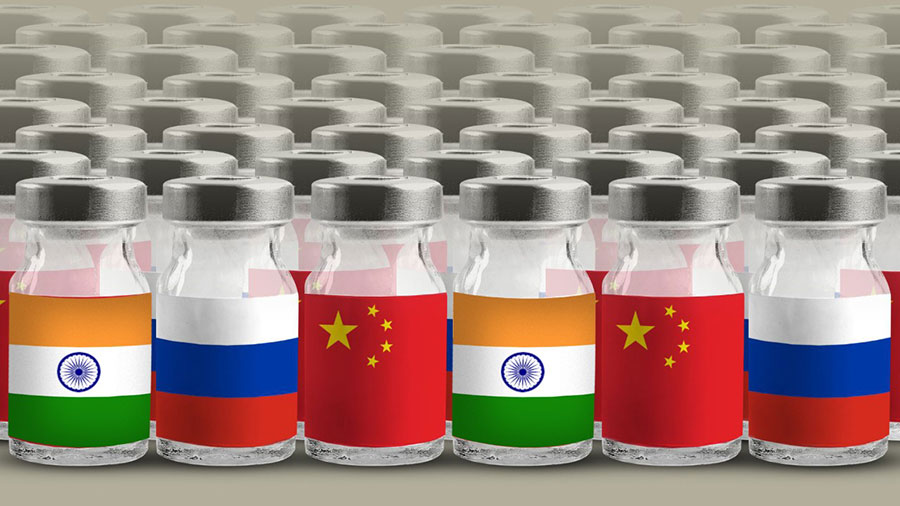China, Russia & India Take The Lead In Global Covid Vaccine Manufacturing & Distribution

Op/Ed by Chris Devonshire-Ellis
- China, Russia and India Now Exporting Covid-19 Vaccines Globally While US and EU Defer
- Millions of Doses Exported Prior To National Programs Completed
- Decisions Not To Share Now May Come Back To Haunt The West Later
China, Russia, and India have taken the lead in sending millions of COVID-19 vaccine doses to countries around the world as Western nations concentrate on vaccinating their own populations first among some squabbling over political issues, supply chain access and whose vaccine is superior. Large populations within the United States and some EU countries have not yet received supplies or are currently facing distribution and logistics problems. Only 5.5% of the EU’s population of 447 million has received a first vaccine dose, according to March 1 data from the World Health Organization, while post-Brexit Britain has achieved about 30%. The United States, after a slow start has currently vaccinated about 20% of its population.
There are some differences in the vaccines being produced in the West and East. The Western vaccines are based on genetically modified material introduced as RNA into a live yet harmless virus. This method is marginally less likely to cause any adverse effect, can be administered in one dose yet requires very low storage temperatures at between -40 to -70 degrees celsius. This has created supply chain issues. The vaccine also has a longer manufacturing process.
The Eastern vaccines are based on RNA sourced from dead Covid-19 virus, and have a slightly greater chance of provoking a adverse effect. It also requires two shots to be effective yet does not require such a degree of cold storage and has a lower production timescale. It is easier to manufacture.
Hybrids between the two different types to generate a vaccine requiring one dose and less demanding storage and transportation requirements are currently underway, with some about to come to market.
China, Russia and India are among the first nations to have reached out to low-income countries that are otherwise unlikely to have widespread access to vaccines until 2023.
China has provided vaccine aid to 53 countries, including non-returnable financial support to enable purchases, and sent vaccines to 27 countries. China has plans to send vaccines to another 40 nations, according to the Chinese Foreign Ministry. Some are within the EU, such as Poland, rejecting the Russian vaccine for political reasons, and with the EU seemingly caught up with distribution inefficiencies. These include a lack of medical refrigerated units required to transport dosages, as Brussels did not fully investigate the logistics supply chain issues and discouraged Astra-Zenica’s vaccine usage as it was British and not an EU product. China has been stepping in to assist when asked, with Chinese companies and government officials working with local partners in Africa and Latin America to create cold-chain infrastructure to help transport and distribute vaccines. China now has four different types of vaccine under production, including a single-shot hybrid. With reported daily coronavirus cases in China now in single digits, China faces less domestic pressure to quickly vaccinate all Chinese citizens but is concentrating on rapid breakout responses to contain any clusters. On March 1, China stated it is aiming to vaccinate 40% of its total population by June this year.
Russia’s Sputnik V vaccine has been approved by 39 countries and began vaccinating its own population in October. It has also applied for EU approval however this has not yet been forthcoming, although EU members Slovakia and Hungary have gone ahead with Sputnik V regardless, with Austria and the Czech Republic also enquiring about supplies. Russia is also shipping vaccines to various nations within Central Asia, South-East Asia, the Middle East, Africa, and Latin America, and is about to approve a ‘Sputnik Light’ single shot hybrid, suitable for the very young, bringing the number of Russian vaccines to three.
India is the world’s largest vaccine manufacturer and is beginning to ramp up production. The current products are based on the British Astra-Zenica vaccine, manufactured in Bangalore, and Russia’s Sputnik V. To date, India has donated vaccines to 17 countries, mainly in the Middle East, Asia, Africa, and South America.
China, Russia and India have all donated vaccines to the United Nations Covax Initiative prior to completing domestic vaccination programmes. The United States and European Union have banned vaccine exports unless prior approved. To date, no exports from Western nations have been permitted to any countries in Asia (except Japan), and no permission to export has been granted at this stage to countries in Africa, the Middle East, and South America.
The response by China, Russia and India to global vaccine provision as opposed to that from the United States and EU will have longer term political repercussions. The former will be considered, and especially among emerging and less wealthy countries, as being more reliable, responsible, and generous when it comes to managing and mending a global crisis.
It will have the additional effect of diminishing the perception of ‘democratic values’ as it has been the global democracies, and especially the United States and EU, who have demonstrated instead a degree of both selfishness and incompetence in their handling of the pandemic. Such differences will make a difference when political and diplomatic tests come to determine one against the other.
Related Reading
- China Coronavirus Updates: Latest Developments and Business Advisory
- COVID-19 Vaccine Roll Outs in ASEAN & Asia – Live Updates by Country
About Us
Silk Road Briefing is written by Dezan Shira & Associates. The firm has 28 offices throughout Asia, and assists foreign investors into the region. For strategic advisory and business intelligence issues please contact the firm at silkroad@dezshira.com or visit www.dezshira.com





